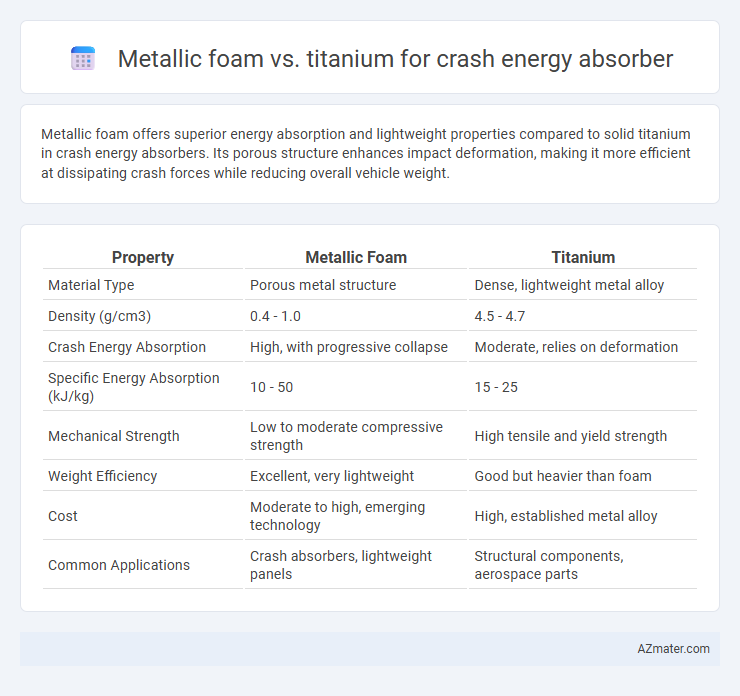Metallic foam offers superior energy absorption and lightweight properties compared to solid titanium in crash energy absorbers. Its porous structure enhances impact deformation, making it more efficient at dissipating crash forces while reducing overall vehicle weight.
Table of Comparison
| Property | Metallic Foam | Titanium |
|---|---|---|
| Material Type | Porous metal structure | Dense, lightweight metal alloy |
| Density (g/cm3) | 0.4 - 1.0 | 4.5 - 4.7 |
| Crash Energy Absorption | High, with progressive collapse | Moderate, relies on deformation |
| Specific Energy Absorption (kJ/kg) | 10 - 50 | 15 - 25 |
| Mechanical Strength | Low to moderate compressive strength | High tensile and yield strength |
| Weight Efficiency | Excellent, very lightweight | Good but heavier than foam |
| Cost | Moderate to high, emerging technology | High, established metal alloy |
| Common Applications | Crash absorbers, lightweight panels | Structural components, aerospace parts |
Introduction to Crash Energy Absorbers
Crash energy absorbers are critical components in automotive and aerospace safety systems designed to mitigate impact forces during collisions. Metallic foams exhibit high energy absorption capabilities due to their cellular structure, providing lightweight yet efficient deformation under impact. Titanium, known for its excellent strength-to-weight ratio and high ductility, offers superior structural integrity but typically at a higher density compared to metallic foams.
Overview of Metallic Foams
Metallic foams offer an exceptional combination of low density and high energy absorption, making them ideal for crash energy absorbers in automotive and aerospace applications. Their cellular structure provides superior deformation under impact, effectively dissipating kinetic energy while maintaining structural integrity compared to solid titanium. Advances in manufacturing techniques have enhanced metallic foam properties, enabling tailored density and mechanical performance to outperform titanium components in lightweight crash protection systems.
Introduction to Titanium as a Crash Energy Absorber
Titanium exhibits exceptional strength-to-weight ratio and corrosion resistance, making it a highly effective material for crash energy absorbers. Its ability to undergo controlled plastic deformation allows efficient dissipation of impact energy while maintaining structural integrity. Compared to metallic foam, titanium offers superior fatigue resistance and durability in high-stress automotive and aerospace crash absorption applications.
Mechanical Properties: Metallic Foam vs Titanium
Metallic foam offers superior energy absorption due to its high strain energy capacity and lightweight porous structure, making it effective in impact mitigation. Titanium exhibits exceptional strength-to-weight ratio and high yield strength, but its solid density results in less energy absorption per unit mass compared to metallic foam. The combination of metallic foam's ability to deform plastically under compression and titanium's high mechanical strength provides distinct advantages depending on crash energy management priorities.
Crash Energy Absorption Efficiency
Metallic foam exhibits superior crash energy absorption efficiency compared to titanium due to its highly porous structure, which enables progressive deformation and effective dissipation of impact forces. Titanium, while strong and lightweight, lacks the same level of energy absorption capacity, often resulting in higher peak forces transmitted during crashes. Studies indicate that metallic foam can absorb up to 50-70% more crash energy per unit mass, making it an optimal choice for automotive and aerospace crash energy absorber applications.
Weight and Density Comparison
Metallic foam offers significantly lower density than titanium, typically around 0.4 to 1.0 g/cm3 compared to titanium's 4.5 g/cm3, resulting in a substantial weight reduction for crash energy absorbers. The lightweight nature of metallic foam enhances energy absorption efficiency by deforming under impact while maintaining structural integrity. Titanium provides higher strength-to-weight ratio but at a much greater density, making metallic foam a preferred choice for applications prioritizing lightweight crash management.
Cost Analysis and Material Availability
Metallic foam offers a cost-effective solution for crash energy absorbers due to lower raw material and manufacturing expenses compared to titanium, which remains significantly more expensive owing to complex extraction and processing techniques. The widespread availability of metals such as aluminum and steel for metallic foams enhances supply chain stability and reduces lead times, whereas titanium's limited natural deposits and high demand in aerospace sectors constrain its availability and inflate costs. Cost analysis reveals metallic foam as a more economically viable option for large-scale automotive applications, balancing performance with material accessibility.
Corrosion Resistance and Durability
Metallic foam exhibits superior energy absorption capabilities due to its lightweight porous structure, but titanium offers significantly better corrosion resistance and durability in harsh environments. Titanium's natural oxide layer provides exceptional protection against oxidation and chemical degradation, making it ideal for long-term use in corrosive or marine applications. While metallic foam can suffer from reduced performance due to corrosion-induced structural weakness, titanium maintains consistent mechanical integrity and crash energy absorption efficiency over extended periods.
Application Suitability in Automotive and Aerospace
Metallic foam offers superior energy absorption due to its high porosity and lightweight structure, making it ideal for automotive crash protection systems where weight reduction enhances fuel efficiency and safety performance. Titanium, with exceptional strength-to-weight ratio and corrosion resistance, suits aerospace crash energy absorbers requiring durability under extreme conditions and repeated stress cycles. Application suitability depends on balancing weight constraints, energy absorption efficiency, and environmental factors, with metallic foam favored in cost-sensitive automotive designs and titanium preferred for high-performance aerospace components.
Future Trends in Crash Energy Absorber Materials
Metallic foams, known for their high energy absorption capacity and lightweight structure, are increasingly favored over titanium in crash energy absorber applications due to their superior crushability and cost-effectiveness. Future trends emphasize the development of hybrid materials combining metallic foam with advanced alloying techniques to enhance impact resistance while maintaining minimal weight. Research is also focusing on additive manufacturing to customize pore structures, optimizing energy dissipation properties for automotive and aerospace safety systems.

Infographic: Metallic foam vs Titanium for Crash energy absorber
 azmater.com
azmater.com